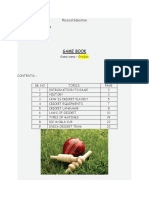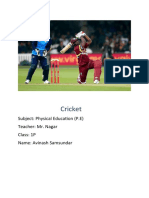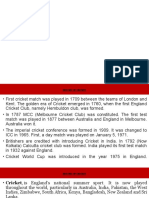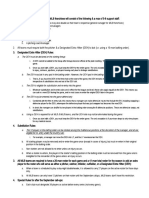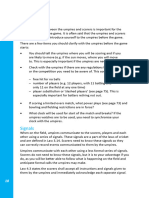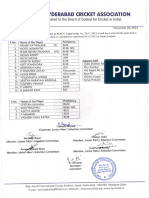Match structure and closure
Main articles: Innings and Result (cricket)
A modern SG cricket bat (back view).
Before a match begins, the team captains (who are also players) toss a coin to decide which team
will bat first and so take the first innings.[69] Innings is the term used for each phase of play in the
match.[69] In each innings, one team bats, attempting to score runs, while the other
team bowls and fields the ball, attempting to restrict the scoring and dismiss the batters.[70][71] When
the first innings ends, the teams change roles; there can be two to four innings depending upon the
type of match. A match with four scheduled innings is played over three to five days; a match with
two scheduled innings is usually completed in a single day.[69] During an innings, all eleven members
of the fielding team take the field, but usually only two members of the batting team are on the field
at any given time. The exception to this is if a batter has any type of illness or injury restricting his or
her ability to run, in this case the batter is allowed a runner who can run between the wickets when
the batter hits a scoring run or runs,[72] though this does not apply in international cricket.[73] The order
of batters is usually announced just before the match, but it can be varied. [64]
The main objective of each team is to score more runs than their opponents but, in some forms of
cricket, it is also necessary to dismiss all of the opposition batters in their final innings in order to win
the match, which would otherwise be drawn.[74] If the team batting last is all out having scored fewer
runs than their opponents, they are said to have "lost by n runs" (where n is the difference between
the aggregate number of runs scored by the teams). If the team that bats last scores enough runs to
win, it is said to have "won by n wickets", where n is the number of wickets left to fall. For example, a
team that passes its opponents' total having lost six wickets (i.e., six of their batters have been
dismissed) have won the match "by four wickets".[74]
In a two-innings-a-side match, one team's combined first and second innings total may be less than
the other side's first innings total. The team with the greater score is then said to have "won by an
innings and n runs", and does not need to bat again: n is the difference between the two teams'
aggregate scores. If the team batting last is all out, and both sides have scored the same number of
runs, then the match is a tie; this result is quite rare in matches of two innings a side with only 62
happening in first-class matches from the earliest known instance in 1741 until January 2017. In
the traditional form of the game, if the time allotted for the match expires before either side can win,
then the game is declared a draw.[74]
If the match has only a single innings per side, then usually a maximum number of overs applies to
each innings. Such a match is called a "limited overs" or "one-day" match, and the side scoring more
runs wins regardless of the number of wickets lost, so that a draw cannot occur. In some cases, ties
are broken by having each team bat for a one-over innings known as a Super Over; subsequent
Super Overs may be played if the first Super Over ends in a tie. If this kind of match is temporarily
interrupted by bad weather, then a complex mathematical formula, known as the Duckworth–Lewis–
Stern method after its developers, is often used to recalculate a new target score. A one-day match
can also be declared a "no-result" if fewer than a previously agreed number of overs have been
bowled by either team, in circumstances that make normal resumption of play impossible; for
example, wet weather.[74]
In all forms of cricket, the umpires can abandon the match if bad light or rain makes it impossible to
continue.[75] There have been instances of entire matches, even Test matches scheduled to be
played over five days, being lost to bad weather without a ball being bowled: for example, the third
Test of the 1970/71 series in Australia.[76]
Innings
�Main article: Innings
The innings (ending with 's' in both singular and plural form) is the term used for each phase of play
during a match. Depending on the type of match being played, each team has either one or two
innings. Sometimes all eleven members of the batting side take a turn to bat but, for various
reasons, an innings can end before they have all done so. The innings terminates if the batting team
is "all out", a term defined by the Laws: "at the fall of a wicket or the retirement of a batter, further
balls remain to be bowled but no further batter is available to come in". [69] In this situation, one of the
batters has not been dismissed and is termed not out; this is because he has no partners left and
there must always be two active batters while the innings is in progress.
An innings may end early while there are still two not out batters:[69]
the batting team's captain may declare the innings closed even though some of his
players have not had a turn to bat: this is a tactical decision by the captain, usually
because he believes his team have scored sufficient runs and need time to dismiss the
opposition in their innings
the set number of overs (i.e., in a limited overs match) have been bowled
the match has ended prematurely due to bad weather or running out of time
in the final innings of the match, the batting side has reached its target and won the
game.
Overs
Main article: Over (cricket)
The Laws state that, throughout an innings, "the ball shall be bowled from each end alternately in
overs of 6 balls".[77] The name "over" came about because the umpire calls "Over!" when six balls
have been bowled. At this point, another bowler is deployed at the other end, and the fielding side
changes ends while the batters do not. A bowler cannot bowl two successive overs, although a
bowler can (and usually does) bowl alternate overs, from the same end, for several overs which are
termed a "spell". The batters do not change ends at the end of the over, and so the one who was
non-striker is now the striker and vice versa. The umpires also change positions so that the one who
was at "square leg" now stands behind the wicket at the non-striker's end and vice versa. [77]
Clothing and equipment
Main article: Cricket clothing and equipmentEnglish cricketer W. G. Grace "taking guard" in 1883.
His pads and bat are very similar to those used today. The gloves have evolved somewhat. Many
modern players use more defensive equipment than were available to Grace, most notably
helmets and arm guards.
The wicket-keeper (a specialised fielder behind the batter) and the batters wear protective gear
because of the hardness of the ball, which can be delivered at speeds of more than 145 kilometres
per hour (90 mph) and presents a major health and safety concern. Protective clothing
includes pads (designed to protect the knees and shins), batting gloves or wicket-keeper's gloves for
the hands, a safety helmet for the head and a box for male players inside the trousers (to protect
the crotch area).[78] Some batters wear additional padding inside their shirts and trousers such as
thigh pads, arm pads, rib protectors and shoulder pads. The only fielders allowed to wear protective
gear are those in positions very close to the batter (i.e., if they are alongside or in front of him), but
they cannot wear gloves or external leg guards.[79]
Subject to certain variations, on-field clothing generally includes a collared shirt with short or long
sleeves; long trousers; woolen pullover (if needed); cricket cap (for fielding) or a safety helmet; and
spiked shoes or boots to increase traction. The kit is traditionally all white and this remains the case
in Test and first-class cricket but, in limited overs cricket, team colours are worn instead. [80]
























